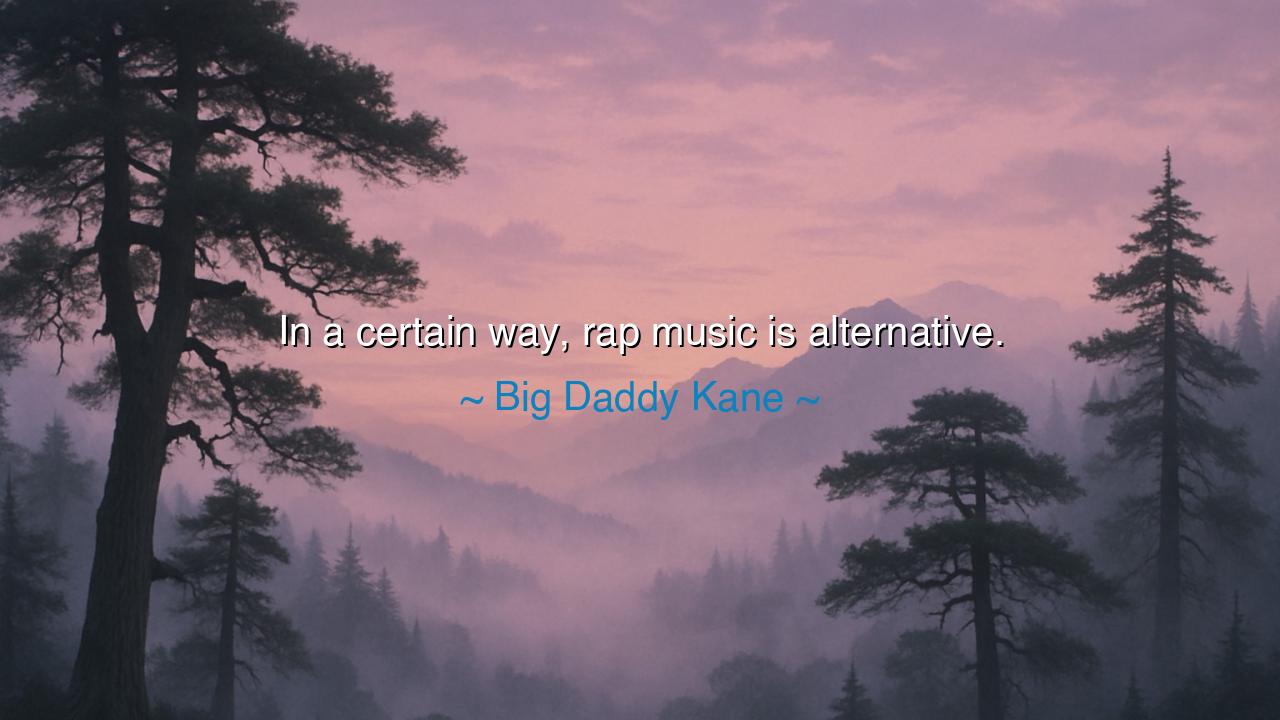
In a certain way, rap music is alternative.






Hear, O seekers of truth, the words of Big Daddy Kane, who declared: “In a certain way, rap music is alternative.” At first these words may seem simple, yet they thunder with meaning. For rap, born in the streets and alleys, did not spring from the gilded halls of accepted art. It rose as the alternative, the voice of those long silenced, the rhythm of the oppressed and forgotten. To call rap alternative is to recognize it as a path apart from the mainstream, a living rebellion, a new way of speaking when old tongues would not suffice.
What is alternative but that which stands in defiance of what is established? In ages past, the poets of court sang of kings and noble deeds, but the poets of the people—troubadours, minstrels, griots—sang of hunger, of love, of survival. So it was with rap. When the mainstream played polished pop and wealthy rock, rap gave voice to neighborhoods where poverty was the daily meal and struggle the daily song. In this way, it became an alternative not just in sound, but in purpose—an art that dared to speak the raw truth that others ignored.
Consider the birth of rap in the Bronx of the 1970s. There, amidst crumbling buildings and abandoned hope, young men and women found expression in beats, in rhymes, in the turning of turntables. They did not have orchestras, nor the blessing of record companies. What they had was their own fire, their own anger, their own joy. They gathered in the streets, creating a new sound out of necessity. Rap was not welcomed at first; it was mocked, dismissed, even feared. Yet like all alternative movements, it persisted—and in persistence, it reshaped the world.
History shows us that this pattern repeats. Recall the rise of jazz in New Orleans. At its birth, it was considered lowly, unworthy, the music of brothels and bars. But jazz, like rap, was the alternative to silence, the alternative to oppression, and it grew until it became a pillar of world culture. What was once dismissed as rebellion became recognized as genius. So too has rap walked this same path: from street corners to the stages of nations, from ridicule to reverence.
The wisdom in Kane’s words is also a reminder: even when art becomes popular, its roots may remain alternative. For rap was always more than music—it was testimony, protest, and prophecy. It challenged systems, called out injustice, and gave the voiceless a microphone. To label it “alternative” is to honor its origin as a force that refused conformity, a current running against the tide of silence.
Thus, the lesson for us is clear: greatness is often born in the alternative, in the paths not taken by the masses. What begins as small, strange, or even despised may grow into the very soul of an age. Do not fear to walk the alternative path. Do not silence your voice when it differs from the crowd. For it is often those who dare to create the alternative who carve new roads for the generations to come.
Practical action follows: seek your own truth, even if it is not welcomed at first. If your art, your work, your ideas are called strange, persist in them. Remember the rappers in the Bronx, who made greatness out of nothing but passion and rhythm. Remember the jazz players, who turned rejection into celebration. Let your alternative be your strength, and do not measure its worth by the approval of the crowd.
And so we pass down Kane’s teaching: “In a certain way, rap music is alternative.” It is the reminder that true power often begins in rebellion, that the path of authenticity is rarely the path of ease. But when walked with courage, it can change the destiny of culture itself. Let us, then, honor the alternative—not as the lesser road, but as the sacred one that leads to transformation.






AAdministratorAdministrator
Welcome, honored guests. Please leave a comment, we will respond soon